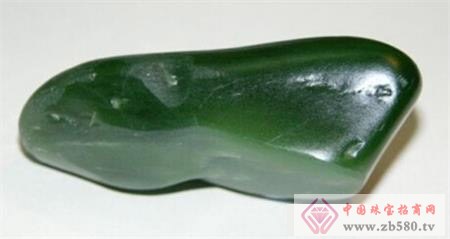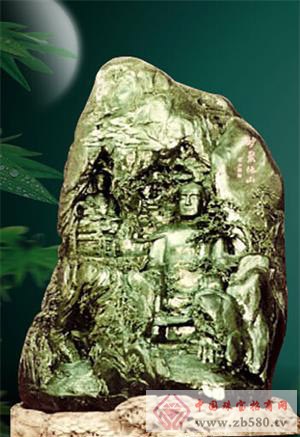
In the depths of the Tianshan Mountains in Manas County, Xinjiang, Xinjiang, it is rich in jasper, known as "Tianshan Jasper" or "Manas Jasper".
The jasper produced by Manas is brightly colored, with fine jade and good luster. It is comparable to Hetian jade in Kunlun Mountain. In the history, Manas is famous for producing large pieces of jasper materials. With the soaring price of jade and jade in the country, many huge jasper materials have appeared in recent years, which has really added a fire to the jade industry. .
The characteristics of Manas Jasper are: the color is spinach green, mixed with a bit of a bit and strips of white spots, while there are ink spots. It is grayish green, dark green, dark green, and the quality of black spots, black spots or jade is slightly worse. The color tone is uneven and has gray and black spots, and the color is pure green. Jasper contains more than 90% of amphibole, and its texture is fine, translucent, and shiny. It is top grade. The color of jasper is heavy and the color is solemn. It is suitable for carving large pieces of landscape ornaments or heavy and simple utensils. There are many excellent jasper boutiques in the jade collection of the Forbidden City.
The ultrabasic rock mass of the Manas-containing jasper mine in Xinjiang is distributed in the area of ​​the Anjihai-Manas-Qingshui River. It is located in the eastern section of the northern Tianshan ultrabasic rock belt. The area is more than 30 kilometers long, hundreds of meters wide, more than 10 mine sites, and abundant reserves. The Xinjiang Autonomous Region Geological Museum also collects samples of several green and moist Manas Jasper. At present, there are six jasper mines and mines, among which the Huangtaizi jasper mine is the main one. In addition, pebbles of jasper are often picked up in the alluvium of rivers and glaciers.
The Xinjiang Manas Biyu Mine has been exploited in ancient times and has a long history. It was famous in the Qing Dynasty. According to historical records, as early as the Qianlong period of the Qing Dynasty more than 200 years ago, the Qing government had set up a green jade factory in Manas. The "Three-State Collection" written in the Qing Jiaqing period said: "Manas City has more than 100 miles, and the name is Qingshuiquan. It is more than a hundred miles away from the west. It is named after the ditch. It is more than a hundred miles away, and the famous ditch is producing green jade. In the fifty-fourth year of Qianlong (1789), the green jade mine was closed and mining was prohibited."
"Xinjiang Tuzhi-Industry (2)" has a note on the jasper produced by the Qingshui River in Manas County; "The Manas River is clear, producing jade, hence the name Qingshui River. , 璞 (引者; 石包玉) The big ones weighed more than ten kilograms. In the north, the river flows into the Wulanwusu River, and more jasper. In the west of the Qingshui River, there is the Cook River in the east of Wulanwusu. (Leader: also known as Ningjiahe), the source of the Qi Latulu Mountain, more green jade, the old green jade factory. Also to the west of the city more than 100 miles, the Hougou ditch, the ditch, all produce green jade ."
"Xinjiang Tu said" also introduced: "Qi Latulu Mountain, one hundred and eighty miles south of Nilai County, the gold version of the jade bottom." This means that the two sides of the river are rich in gold, and the bottom of the river is also producing jade, which is really the hometown of gold and jade. ". "The Western Regions Map" contains: "The Jewish name of the Junggar Department, the name of the Haas, the color is more green than the blue.
After the cessation of mining in the Qing Dynasty Green Jade Plant, the original jasper mine mouth has been unknown for many years. In the long history, the original mine of Manas Jasper was buried underground for a long time and was not developed. It is said that there were private merchants mining jade around 1928, but there was no news soon. In 1935, the Soviet M. Saytov had conducted a geological survey here, but did not report the discovered mines. Until 1973, a national gemstone meeting held by the Ministry of Light Industry proposed that the source of jasper in Xinjiang should be ascertained as soon as possible, and developed and utilized. After the five battalions of the Xinjiang Geological Bureau (the second regional geological survey team) sent people into the mountains several times, the source of the census was finally found. In 1973, the original production area of ​​jade was found in the area of ​​Manas Nanshan. The local government attached great importance to it. It was built in 1974 and built the Manas jade factory. In that year, it produced dozens of jasper and supplied more than ten jade carving factories in Shanghai, Yangzhou and Guangzhou.
In 1975, a 750 kilograms of large jasper was mined in the red pit of the Manas River. The jade carving of the stone carving "Jianzheng Juzhen" by the Yangzhou Jade Factory was collected in the Chinese Arts and Crafts Museum in Fuxingmen, Beijing.

Stone carving
This jasper material is produced in the Manas area of ​​Xinjiang, weighing more than 1,000 kilograms, 120 centimeters high, 90 centimeters wide and 60 centimeters thick. The color of the carvings is green and deep, and the jade is fine and natural. The author makes full use of its natural and beautiful jade shape, depicting the treasures in the stone carving art treasures such as the Leshan Giant Buddha in Sichuan, the Dazu Rock Carvings, the Longmen Grottoes in Henan, and the Yungang Grottoes in Datong, Shanxi, so that the four famous mountain caves gather together and share Among the green mountains and rivers.
Black Jogger Pants,Jogger Pants,Skinny Jogger Pants,Knit Legging Pants
SHAOXING YINBO IMP&EXP CO.,LTD , https://www.yinbotex.com